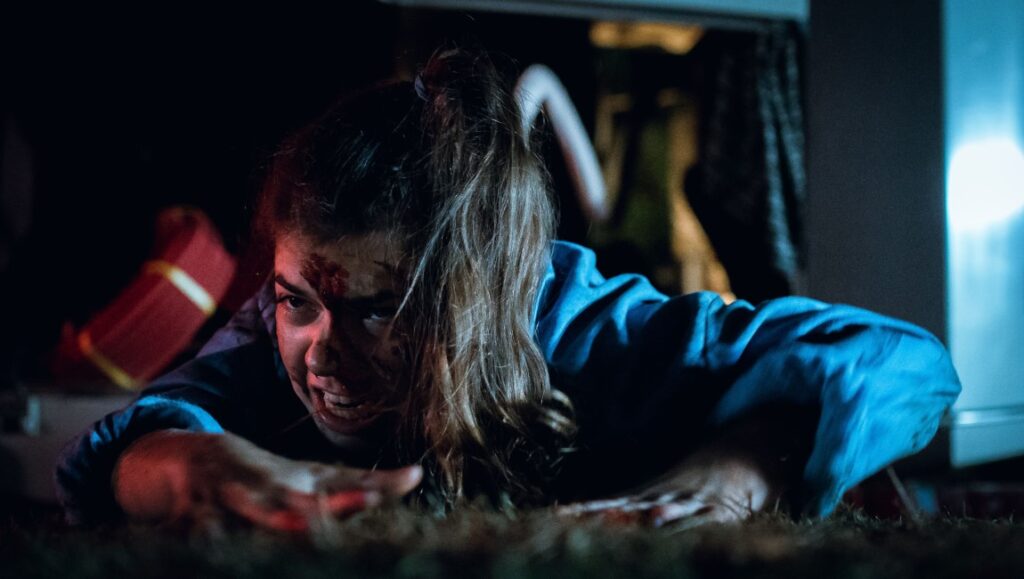The Passenger boasts a duo of capable directors behind the camera, but little beyond the impressive visuals lands with any force.
Those looking for a semi-woke update of the alien invasion flicks of yesteryear might be a little more forgiving of The Passenger, a Spanish horror flick that features a few gooey moments of impressive practical effects and capable filmmaking, and not much else. Blanco (Ramiro Blas) is a fifty-something former bullfighter who now spends his days shuttling various passengers around Spain as a rideshare driver. The love of his life is his minivan, a boxy white and brown relic from years past named Vanessa. She’s seen better days but can still get the job done in a pinch, proving that writers Javier Echaniz and Asier Guerricaechebarria at least have a baseline understanding of symbolism. It must also be stated upfront that Blanco is a misogynistic pig, the type of guy who casually drops the other hard F-word in normal conversation and thinks women should be seen and not heard. Indeed, he’s immediately called out on his sexist behavior by his latest clients, including no-nonsense nurse Mariela (Cecilia Suárez) and mother-and-daughter Lidia (Cristina Alcázar) and Marta (Paula Gallego). Blanco stares lasciviously at Marta from the moment of her arrival, even though the girl is 15 years old, tops. Mom is understandably appalled, but they need to get to the city in order to see Marta’s long-absent father, who is temporarily housing the girl due to a job opportunity too good for Lidia to pass up. Suffice it to say, tensions are high, and that’s before Blanco stumbles upon what appears to be the crash site of an alien spacecraft. In the midst of the ensuing chaos, Marta becomes infected by an alien parasite, while a comatose woman near the site — in fairness, comatose because Blanco inadvertently ran over her — wreaks havoc during an impromptu drive to the hospital. It isn’t long before Blanco and Marta are forced to team up to survive the night, stalked by a suddenly-infected Lidia, who has been gifted with superhuman speed and strength and seeming immortality.
There is something decidedly old school about The Passenger, playing a bit like a riff on the likes of Night of the Creeps. The pleasing practical effects are appropriately slimy, although they also serve to make the CGI used intermittently throughout even dodgier in comparison. Unfortunately, Blanco is quite the reprehensible human being, and the fact that the film keeps trying to paint both his age and upbringing as some sort of legitimate excuse for his behavior is a brassy, borderline offensive position to assume. At the same time, the film continues to call the character out on his rampant bullshit, but this mostly lands as a misguided attempt to both have cake and eat it. Indeed, the implication is made that Lidia is stalking Blanco because of his toxic ways, which is an interesting approach to take to the material, but it’s executed with such half-assed commitment that it never lands with the satirical touch that was obviously intended. There’s also a dangling plot thread about Lidia abandoning her daughter both literally and figuratively, and the subsequent repercussions, but that is discarded as quickly as it is introduced, its inclusion here cursory at best. Despite all that, directors Fernando González Gómez and Raúl Cerezo exhibit undeniable filmmaking chops throughout, even expertly utilizing split diopter for one particularly intense scene that would be sure to get the De Palma seal of approval. The film as a whole actually takes on a similar visual texture to those old B-movie chestnuts, a reverie for key camera placement in cramped quarters that also breeds ingenuity in crafting movement. And the directors get a lot of mileage out of a simple plastic divider that separates the vehicle’s front and back seating areas, utilizing in service of both comedy and to create key moments of tension. And this makes for the general crux of The Passenger: it’s the kind of film that inspires admiration in spurts but fails to ever encourage real investment from the viewer. It doesn’t help matters that the aliens are largely rendered as a riff on the zombies from 28 Days Later, their presence lending a tinge of nostalgia but nothing of novelty and imagination. Gómez and Cerezo clearly know their way around a camera, but they’ll need to find better passengers for their next journey.
Published as part of Before We Vanish — June 2022.


Comments are closed.